|
|
|
Published
on 21
Dec 2009
|
All rights reserved.
|
|
|
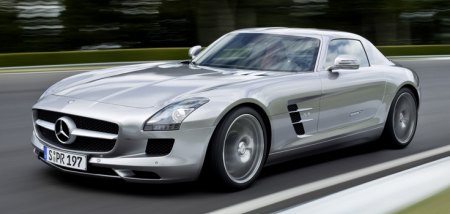
|
AMG proves that it can build better
cars than McLaren SLR, even at half the price !
|
From
2003 to 2009,
Mercedes-McLaren built about 2,100 units of SLR, making it the highest
selling supercar ever made. However, the SLR has never got the
admiration Mercedes expected. People criticized its excess weight,
stiff ride, numb steering and brake. No one regarded it as great as
contemporary supercars like Porsche Carrera GT, Ferrari Enzo or Bugatti
Veyron, and most prefer to drive a (much cheaper) Ferrari 599 GTB
instead. It's no secret that the Anglo-German partnership has never
been a happy memory to both parties. Although they did not blame each
other openly, they thought they could do much better had they went on
their own. Eventually, they broke up – both in F1 and road car – and
started their own ventures.
On September 8th, 2009, McLaren unveiled its own supercar, MP4-12C, to
the public. Interestingly, in less than 24 hours, Mercedes responded
with its new SLS supercar. The SLS is the first car developed by AMG
division from ground up, rather than modified from Mercedes' mainstream
models. Costing an estimated £150,000, it will compete with the
McLaren supercar as well as established rivals like Ferrari 458 Italia,
Lamborghini Gallardo LP560-4, Porsche 911 GT2 and Audi R8 V10. However,
I suppose most comparison will be drawn with the new McLaren. Now both
companies are given full freedom to design their cars, which one will
be
better? We won't get the answer until the McLaren goes on sale in 2011,
but right now the Mercedes supercar is available for our evaluation.
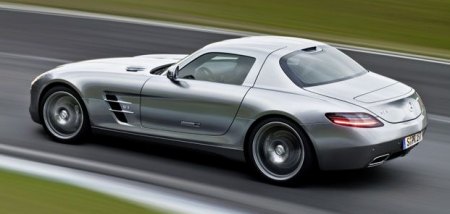
|
This is easily one of the most
distinctive cars in the world since Weinermobile...
|
At first glance, the SLS does not look like a proper
supercar. This is because it has an ancient appearance deliberately
resembling the 1950s 300SL Gullwing, which is still the definitive
Mercedes sports car until today. It has a big mouth, followed by a long
long bonnet, an upright windscreen and a small cockpit that sits near
the rear axle. This profile speaks little about speed and aerodynamic
efficiency. Moreover, its low, sloping tail clearly works against the
requirement for downforce, so it needs a retractable rear spoiler to
provide the necessary stability at speed. Modern aerodynamics usually
shape supercars like wedges. In contrast, the SLS looks like a big
German sausage, especially in red. This is easily one of the most
distinctive cars in the world since Weinermobile.
A beauty it may not be, but the SLS is unquestionably
very well engineered. Its wide and
long-wheelbase chassis is constructed
entirely from aluminum, i.e. extrusions, castings and pressed sheets,
as are the outer body panels. Lacking carbon fiber in its construction
does not prevent it from undercutting SLR on the scale – at 1620 kg
with fuel and coolant, it is between 30 and 70 kilograms lighter
than its carbon-fiber predecessor, although you may say Ferrari 458 and
Lamborghini Gallardo are lighter still.
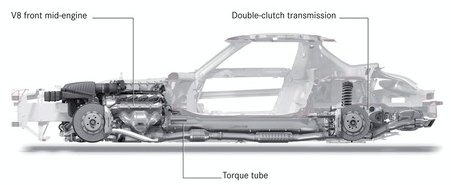
|
The whole engine is mounted well
behind the front axle...
|
The AMG chassis is also very well
balanced - or indeed
perfectly balanced - with 47:53
weight distribution front to rear. This is easily understandable when
you see its engineering drawing. The whole engine is mounted well
behind the front axle (that explains why the bonnet is so long) and
counter-balanced by a transaxle mounted at the rear axle. Linking
between them is a strong aluminum torque tube, inside which a
lightweight carbon-fiber drive shaft is spinning at engine speed to
drive the gearbox and rear wheels. This
arrangement can be seen in every front-engined Ferrari or manual-box
Maserati. It goes without saying that it delivers excellent balance and
low polar moment of
inertia. Worth noting is that, unlike Ferrari or Maserati, AMG puts the
gearbox aft of the rear axle in order to achieve the rear-biased weight
distribution. This theoretically increases its polar moment of inertia
a bit.
Compared to SLR, the biggest advancement of SLS is probably its
gearbox. Here comes a modern 7-speed dual-clutch gearbox, versus the
outgoing 5-speed automatic. It compensates the reduced torque output of
the naturally aspirated engine with its closer ratios and far
quicker gearshift. The gearbox is supplied by Getrag based on the one
debuted in Ferrari California. About 70 percent of its components are
common to the Ferrari's, but the ratios and program are unique to AMG.
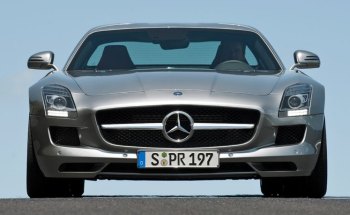
|
6.3-liter V8 gains even more firepower
in this car...
|
At first, I was a little bit disappointed to hear that the
SLS engine is again that AMG 6.3-liter V8. You know, these days there
are no less than eight AMG models employ this engine, including the
entry-level C63 and the mud-on-your-face ML63. It sounds not exotic
enough for AMG's flagship supercar, doesn't it ? Think twice, however,
there seems to be nothing wrong. We always regard the 6208 cc V8 as one
of the world's best engines. It has great horsepower, great torque and
great sound to shut up the unbelievers. Moreover, the new version
codenamed M159 (instead of M156 in other AMG models) has undergone
considerable improvements. Now the V8 is converted to dry-sump
lubrication in order to lower
its center of gravity. Its intake manifolds, intake ports and exhaust
are modified to enhance breathing, while hotter cams and valvetrain,
lighter forged pistons and stronger crankshaft also contribute to extra
power. The result is 571 horsepower at 6800 rpm, 46 ponies higher than
the most powerful version of its siblings. Maximum torque inches up 14
pound-feet to 479 lb-ft, and appears earlier at 4750 rpm instead of
5200 rpm. This makes the SLS slightly more powerful than rivals 458
Italia and Gallardo, and significantly more torquey than them. It is
not as powerful as the V12-powered 599 GTB though, but it has more
twisting force to haul a lighter body, so theoretically its performance
should be comparable to the flagship Ferrari GT.

|
SLS is the most beautiful with its
gullwing doors opened...
|
Then
how
fast is it ? AMG claims it can sprint from 0-60 mph in 3.7 seconds if
you activate the "Race Start" gearbox mode.
That rests on the same level as the outgoing SLR
and the absurdly expensive Lexus LF-A. However, if the manufacturer's
figure is accurate, it won't be as quick as Ferrari 458 and 599 in
straight line acceleration. These Ferraris utilize their
ultra-responsive gearbox and sophisticated traction control to achieve
0-60 in
the range of 3.2 to 3.4 seconds, and 0-124 mph in less than 11 seconds.
The latter is 1 full second quicker than the AMG. They can also easily
crack
into the
200 mph barrier. Strangely, AMG claims SLS is "electronically
regulated" to 197 mph, some 12 mph slower than the outgoing SLR 722, so
it won't be the fastest Mercedes-Benz road car in history. I suspect
even with regulator disabled, its top speed would be much the same due
to its poor aerodynamic drag of 0.36. Adding speed regulation is just a
way to save its face.
Other aspects of the car are quite conventional. Its suspensions are
all-round aluminum double-wishbones with fixed rate dampers. Standard
stoppers are large steel brakes (390mm discs and 6-pot calipers up
front, 360mm discs and 4-pot calipers at the rear), while ceramic
brakes are optional. The AMG design wheels are 19-inch and 20-inch
front and rear respectively. They wear Continental high-performance
tires measuring 265/35 and 295/30 respectively. Electronics are simpler
than Ferrari's. You get ABS, ESP and four choices of transmission mode
(including the aforementioned "Race Start" launch control), but it
lacks an integrated chassis control system, or the ability to alter
suspension or differential setting, because both are passive devices.
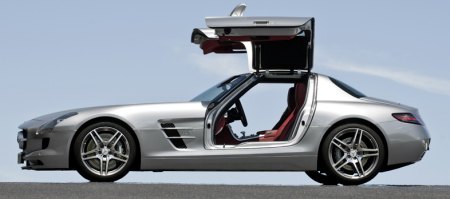
|
Remember to grab the door handle
before dropping into the seat... |
On the Road
Visually, the SLS is the most beautiful when it is parked stationary
and has its gullwing doors opened. In this form, few cars can cause as
much sensation. The original 300SL adopted gullwing doors because of
its unusually wide sills, which required the driver to climb from
above, hence the need of opening part of the roof. The new car's sills
are much narrower. You sit on the sill, thread your legs into the
footwell and drop yourself into the deep bucket seat. Now you may
wonder
how to close the door. Mercedes should have installed power doors, but
for weight saving it didn't, so you will need to climb back to the
sill, grab the door handle and close the door while dropping into the
seat. Fortunately, the aluminum doors are fairly light and easy to
close.
Once you are in the cockpit, you will find a very snug environment. The
dashboard and the upright windscreen are very close to you. There is no
space behind the seats, so fore and aft adjustment is limited. People
over 6 feet tall may find headroom and legroom tight. Interior storage
is limited to a tiny glovebox. The dashboard design is classical, with
some chromed gauges and air vents, aluminum or carbon-fiber decors on
the center console. You can order red stitched leather to enhance the
classical ambience further. Anyway, it doesn't look very like a
supercar cabin as it lacks the exotic factor. Visibility is
another problem. Forward view is hampered by a long bonnet.
Rearward view is better, but the swoopy tail means you can hardly judge
its exact location. Parking takes special precaution.

|
Classical rather than exotic here... |
However, all these faults become insignificant when the
motor roars
into life. Those accustomed to the SLR's supercharged V8 will
immediately notice its new found enthusiasm - the throttle response
much sharper, the power delivery more linear and the sound more
delicious. The bottom-end punch might be softer, but once into 2000
rpm, where 369 lb-ft is available for disposal, it becomes really
really strong, and the car accelerates with the urgency you would
expect for a junior supercar. Its smoothness and its enthusiasm for rev
are remarkable for such a big-capacity V8. As rev rises, the V8 rumble
is gradually
substituted by a race car thunder towards its 7200 rpm cut-out. Having
said that, the AMG V8 is not the best sounding engine in the class.
Ferrari's V8, Lamborghini's V10 and Toyota's V10 produce more addictive
sound when they approach 8000 or even 9000 rpm.
The AMG voice and linear power delivery are also slightly hampered by
the 7-speed dual-clutch gearbox. While its smoothness is beyond
criticism, the gearchange has noticeable delay compare with the
dual-clutch gearboxes on Ferrari or Porsche. Although AMG said its
calibration is yet to finalize, I suspect the tremendous torque of its
engine may present greater difficulties to quicken its gearchange.
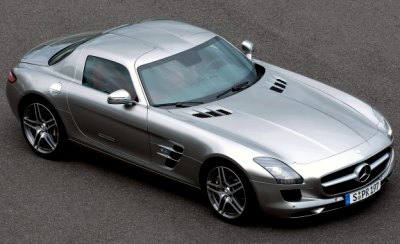 |
AMG cars used to be big on power and
weak on chassis. The SLS is totally different...
|
The big surprise is its chassis. AMG cars used to be big on
power and weak on chassis. The SLS is totally different. Storm it on a
race track, you will be amazed with its great balance and immense
stability. The low center of gravity is obvious, as is the incredible
stiffness of its chassis and the formidable brakes. You can go very
fast and deep into bends without breaking its grip or distorting its
neutral attitude. Its steering is swiss-watch accurate, if not as sharp
as the helm of Ferrari or as tactile as Porsche's. Being a
front-mid-engined machine, its handling is inherently tidier than its
mid or rear-engined rivals. You have to be really aggressive to swing
it into oversteer. If you succeed to do so, you may discover the raw
side of its handling, because the way its tail break loose is sudden
and unpredictable. However, on public roads it will be very difficult
to approach its limit, especially with the safeguard of ESP.
The most impressive of all is its combination of fluid handling and a
forgiving ride. The lack of adaptive suspension is compensated with
well-judged damping, so the SLS is a terrific long-distance cruiser.
In many ways the SLS is a strong rival to Ferrari 599. Ultimately, it
is not as sharp or as engaging to drive as the Ferrari. However, it is
unquestionably the best sports car Mercedes has ever built, one that
easily wash away the unhappy memory of SLR. Well done AMG.
|
Verdict:     |
| Published
on 10
Nov
2012 |
All rights reserved.
|
|
SLS AMG GT
|
|
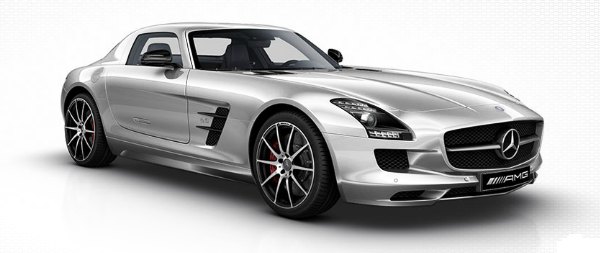
|
The "GT" label is often
misused. It originally referred to those large and powerful high-speed
long-distance coupes. By this definition, Mercedes SLS AMG should be a
GT. So what does it mean when Mercedes add a "GT" label to the SLS? The
GT of GT? I wonder if Stuttgart can give a satisfying answer.
If I were the product planner of Mercedes, I would have called it SLS
AMG+ instead, because this car is actually an SLS plus something –
slightly more power, slightly better control and slightly quicker
gearshift. It doesn't transform the car, but it is definitely a plus to
keen drivers.
You might have trouble to tell the additional 20 horsepower that the
6.2-liter V8 produces through its modified intake manifold and ECU, but
you can easily tell the 7-speed dual-clutch gearbox now shifts faster
in attack mode, with less delay between ratios, although it still fails
to match Ferrari 458 or McLaren MP4-12C. There is no change to the
Getrag hardware, just a new software can make a big difference.
The suspension is no lower than the standard car, but it gets 30
percent stiffer springs, thicker anti-roll bars and stiffer shock
absorbers as well. The adaptive damping – added to the standard car
since last year – in the GT skips Comfort mode, leaving only Sport and
Sport+. Never mind, the former is good enough to take on the majority
of road surfaces while the latter is best reserved to race tracks. The
suspension mods sharpens the turn-in and improves cornering balance a
little. Body roll and understeer are both reduced, leading to a more
stable rear end. Compare with these improvements, the slightly less
comfortable ride and more road noise are worthwhile tradeoffs.
Nevertheless, with price inflated by 7 percent to £180,000, the
SLS GT is uncomfortably close to its Ferrari and McLaren rivals, which
are obviously the more desirable yet accomplished choices. Add another
£60,000, you can even get the latest Ferrari F12, which
overwhelms the AMG in every area. After all, the GT of GT is no
match for the Supercar of GT.
|
Verdict:     |
Published
on 30
Mar 2013
|
All rights reserved.
|
|
SLS AMG Black
|
|
If the mildly tuned SLS AMG
GT cannot satisfy you, this SLS AMG Black series could be the answer.
Headline numbers include 631 horsepower and 1550 kg kerb weight, which
is better than the GT by 40 hp and 70 kg respectively. Moreover, the
car gets closer to the territory of GT3 race car, as you can see from
its extended fenders and aggressive aero kits. Apparently, the Black is
strongly oriented to race tracks.
The engine is still that M159 6.2-liter naturally aspirated V8
– expect to be the last incarnation before turbocharging taking over – but it
gets hotter tuning such as faster cams, high-flow intake manifolds,
low-friction tappets and revised ECU to boost top-end output. Now
output peaks at 7400 rpm (up 600 rpm) and the maximum rev is raised
from 7200 to 8000 rpm, incredible for a large V8. It comes at the
expense of torque though - peak torque is down 11 lbft to 468. In order
to withstand the hard use on race tracks, the engine gets strengthened
oil and water cooling system, as well as new main bearings and
gas-filled strut brace.
The 7-speed DCT gearbox gets faster shift program for Sport+ and Manual
mode. It is also mounted 10 mm lower in the chassis to improve CoG. A
gas-filled mounting strut controls its movement more tightly.
Meanwhile, the mechanical limited slip differential has been replaced
with an electronically controlled unit. This should correct the biggest
flaw of the SLS, i.e. a wayward tail.
The chassis is also heavily modified. Wider fenders conceal wider
tracks (+20mm front and +23mm rear) and wider tires (10 mm wider up
front and 30 mm wider at the rear). The tires are super-sticky Michelin
Pilot Sport Cup 2, same as those to be used on Porsche 918 Spyder. The
already quite stiff suspensions are stiffened further by as much as 50
percent front and 42 percent rear, so don't expect a GT ride. Ceramic
brakes become standard fitment. Least change is the steering, which
gets only recalibrated assistance curve.
The 70 kg of weight reduction is achieved with a titanium exhaust (-13
kg), carbon-fiber torque tube (connecting between engine and transaxle,
cuts 13 kg compared with the cast aluminum one on standard car),
Lithium-ion battery (-8 kg), ceramic brakes (-16 kg) and lightweight
alloy wheels (-4 kg). Besides, a lot of external panels are made of
carbon-fiber, such as the bonnet, front air splitter, winglets, side
skirts, rear spoiler, diffusers and diagonal underbody braces.
So how does it drive on the road?
No one knows, actually. The first round of road test was limited to the
super smooth Paul Ricard racing track in France – AMG dismissed the
chance to test it on the public roads outside. However, even on the pit
lane of Paul Ricard you can feel the harshness of its suspension. No
doubt it will turn out to be a nightmare on regular public roads. If
you don't do track days, you had better to avoid it. The regular SLS GT
will be much better to use as a day-to-day supercar (even though itself
is not as great as Ferrari 458 or McLaren MP4-12C in our eyes). In
contrast, the SLS Black series is essentially a road-legal track car.
It is easily the most track-oriented AMG ever made, with the exception
of CLK-GTR. Therefore it is a
niche of the niche. No wonder only 350 cars will be built, each costs
£230,000, some £60,000 more than a standard SLS and even
eclipses Ferrari F12 Berlinetta!
Back to the track, the car performs very well. Its engine revs harder,
reacts faster to throttle and sings angrier like a racing motor. AMG
people must be extremely proud what they have done before sending their
big naturally aspirated V8 into history! Not so good is the dual-clutch
gearbox. Although its gearshift gets faster, it is still too slow at
times compared with the DCTs on Ferrari or McLaren. Perhaps the inertia
of the big V8 is too difficult to overcome. That said, it is no doubt
that the SLS Black is a very fast machine, perhaps faster than the 0-60
mph time of 3.5 seconds suggested.
The handling is improved even more. Not only the new tires generate
more grip and the aero kits generate more downforce to enable higher
cornering speed, the tail is also much better tamed with the widened
track and electronic LSD. Now it feels more planted, more stable in
corners, allowing you to get back on throttle earlier in corner exit
with more confidence. There is some understeer in the turn-in phase
though, as you can sense the big V8 is lying near the front axle, but
it helps stabilizing the car. Other aspects are just excellent. Thanks
to the stiff suspension setup, there is precious little body roll. The
chassis also feels more rigid due to the carbon-fiber torque tube. The
ceramic brakes are truly capable for track use, with good feel from the
pedal, too.
That said, the SLS Black is not the last word of its kind. A Porsche
997 GT3 RS feels even sharper and more precise as a track tool, yet it
should ride better on roads and cost half the money. On the other hand,
Ferrari F12 is a far more accomplished road car, being faster, more
sophisticated and far more versatile. The Black series' appeal is too
narrow. That is why its production has to be limited.
|
Verdict:     |
| Published
on 30
Mar 2013 |
All rights reserved.
|
|
SLS Electric Drive
|
|
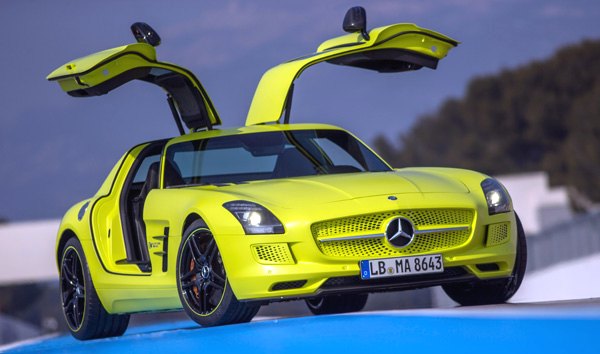
|
The SLS Electric Drive is
not only the fastest electric car in the world but also the most
powerful Mercedes-AMG model ever made. Its 751 electrifying horsepower
and 738 pound-foot of instantly available torque eclipse even SLS Black
series (631 hp / 468 lbft) and the late SL65 AMG Black (670 hp / 738
lbft). Equally staggering is its price tag – €350,000 plus tax in
Europe, or more than twice the price of the standard SLS! Is AMG
getting crazy?
No, the SLS Electric Drive is not about business. It is a tour de force
of technology. I have no doubt that this car will be built at a loss if
its development budget is taken into account. It is admirable that
Mercedes-AMG does not care about money and concentrates solely on
exploring the technology of the future. Tesla Roadster might be the
pioneer of electric sports car, but SLS Electric Drive takes the
technology to a different level. It utilizes not just one or two but 4
identical AC synchronous motors, each of them drives an individual
wheel through a step-down gearbox so that it can assign whatever amount
of torque to each wheel as desired. The result is the most variable
4-wheel drive and torque vectoring ever seen. Theoretically, it can be
programmed to deliver faster and more accurate maneuvering than
conventional cars.
To keep unsprung weight low, AMG mounts the motors inboard near the
center line of the car rather than using in-wheel motors. They drive
the associated wheels with half shafts. Unfortunately, the latter is
not compatible with the standard car's double-wishbone front
suspensions owing to the lack of space, thus the latter are replaced
with a new multi-link setup with pushrod-operating inboard
spring/damper units. In this aspect the Electric Drive looks even more
racy than SLS Black.

|
The aluminum spaceframe chassis is vastly modified, too. Its aluminum
backbone is replaced with a highly rigid carbon-fiber monocoque which
houses the lithium-ion battery, protecting the latter from crash
damage. The 60kWh battery weighs an immense 548 kg as it needs to
provide a range of 200 km (124 miles). It lifts the kerb weight to 2.1
tons thus explains why the Electric Drive is slightly slower than the
standard SLS, with 0-60 mph claimed at 3.8 seconds. Top speed is
limited to 155 mph to avoid abusing the battery and power inverters. On
the plus side, the mass of the battery concentrates in the center and
close to the floor of the car, lowering center of gravity and reducing
polar moment of inertia.
How does it work in reality? As expected, with 738 lbft of torque
delivered right from startup, the sense of acceleration is immense,
much stronger than the SLS Black. The integrated traction / stability
control / torque vectoring system called "AMG Torque Dynamics" manages
wheel spin very well, so it feels very much like a Bugatti Veyron in
acceleration. There are 3 modes on offer: Comfort limits power to 590
hp and gives a more relaxing handling characteristic; Sport weighs up
the electro-hydraulic steering, sharpen the turn-in through torque
vectoring and reduces the intervention of ESP; Sport+ releases the full
power and sharpen the handling even further. Their characteristics are
more differentiated than in conventional cars as the 4-motors system
gives much higher freedom of tuning. In Sport+, the car feels keener to
steer and more neutral than the standard SLS so that you don't feel the
extra weight at all. It can still oversteer if you push hard, but the
torque vectoring engages quickly to settle the tail. The only problem
is your correction might conflict with the computer's. Its software
still needs some fine tuning to deal with all kinds of conditions.
That said, the driving experience is not as exciting as the
petrol-drinking car. The civilized, washing machine-like noise of
electric motors is absolutely uninspiring. Not even the artificial
engine noise generated by the audio system can compensate. Likewise,
the instantly available torque makes the power delivery feels more
digital than analogue, lacking the organic build-up of combustion
engines. The regenerative braking is also not as intuitive to use as
conventional brakes, although it is not as non-linear as in some EVs.
Besides, with 2.1 tons of weight to carry, not even the ceramic brake
discs can claim to be reassuringly powerful. These problems mean the
Electric Drive is not as engaging to drive as its petrol-powered
siblings.
|
Verdict:     |
|
|
|
|
|
|
|
|
|
|
SLS AMG
|
2009
|
| Front-engined,
RWD |
Aluminum spaceframe
|
| Aluminum |
| 4638 / 1939 / 1262 mm |
| 2680 mm |
V8, 90-degree
|
| 6208 cc |
DOHC 32 valves, DVVT
|
| - |
| - |
571 hp / 6800 rpm
|
479 lbft / 4750 rpm
|
7-speed twin-clutch
|
All double-wishbones
|
| - |
F: 265/35ZR19
R: 295/30ZR20
|
1620 kg
|
197 mph (c) / 196 mph*
|
3.7 (c) / 3.9* / 3.5** / 3.6*** /
3.9****
|
| 7.7* / 7.5** / 7.7*** / 8.0**** |
|
SLS AMG GT
|
2012
|
| Front-engined,
RWD |
Aluminum spaceframe
|
| Aluminum |
| 4638 / 1939 / 1262 mm |
| 2680 mm |
V8, 90-degree
|
| 6208 cc |
DOHC 32 valves, DVVT
|
| - |
| - |
591 hp / 6800 rpm
|
479 lbft / 4750 rpm
|
7-speed twin-clutch
|
All double-wishbones
|
| - |
F: 265/35ZR19
R: 295/30ZR20
|
1620 kg
|
199 mph (c)
|
3.6 (c) / 3.8**
|
| 7.8** |
|
SLS AMG Black
|
2013
|
| Front-engined,
RWD |
Aluminum spaceframe
|
Aluminum, carbon-fiber
|
| 4638 / 1965 / 1262 mm |
| 2680 mm |
V8, 90-degree
|
| 6208 cc |
DOHC 32 valves, DVVT
|
| - |
| - |
631 hp / 7400 rpm
|
468 lbft / 5500 rpm
|
7-speed twin-clutch
|
All double-wishbones
|
| - |
F: 275/35ZR19
R: 325/30ZR20
|
1550 kg
|
196 mph (c)
|
3.5 (c) / 3.2** / 3.7*****
|
7.0** / 7.6*****
|
|
|
|
|
|
Performance
tested by: *Quattroruote, **C&D, ***R&T, ****Autocar, *****AMS
|
|
|
|
|
|
|
SLS AMG Electric Drive
|
2013
|
Front
and rear motors, 4WD
|
Aluminum spaceframe, carbon-fiber
backbone
|
Aluminum
|
| 4638 / 1939 / 1262 mm |
| 2680 mm |
4 electric motors
|
| - |
-
|
| - |
| - |
751 hp
|
738 lbft
|
1-speed gearboxes
|
F: multi-link
R; double-wishbones
|
| - |
F: 265/35ZR19
R: 295/30ZR20
|
2110 kg
|
155 mph (limited)
|
3.8 (c)
|
| - |
|
|
|
|
|
|
|
Performance
tested by: -
|
|
|
|
|
|
|
|
|
Copyright©
1997-2013
by Mark Wan @ AutoZine
|
|